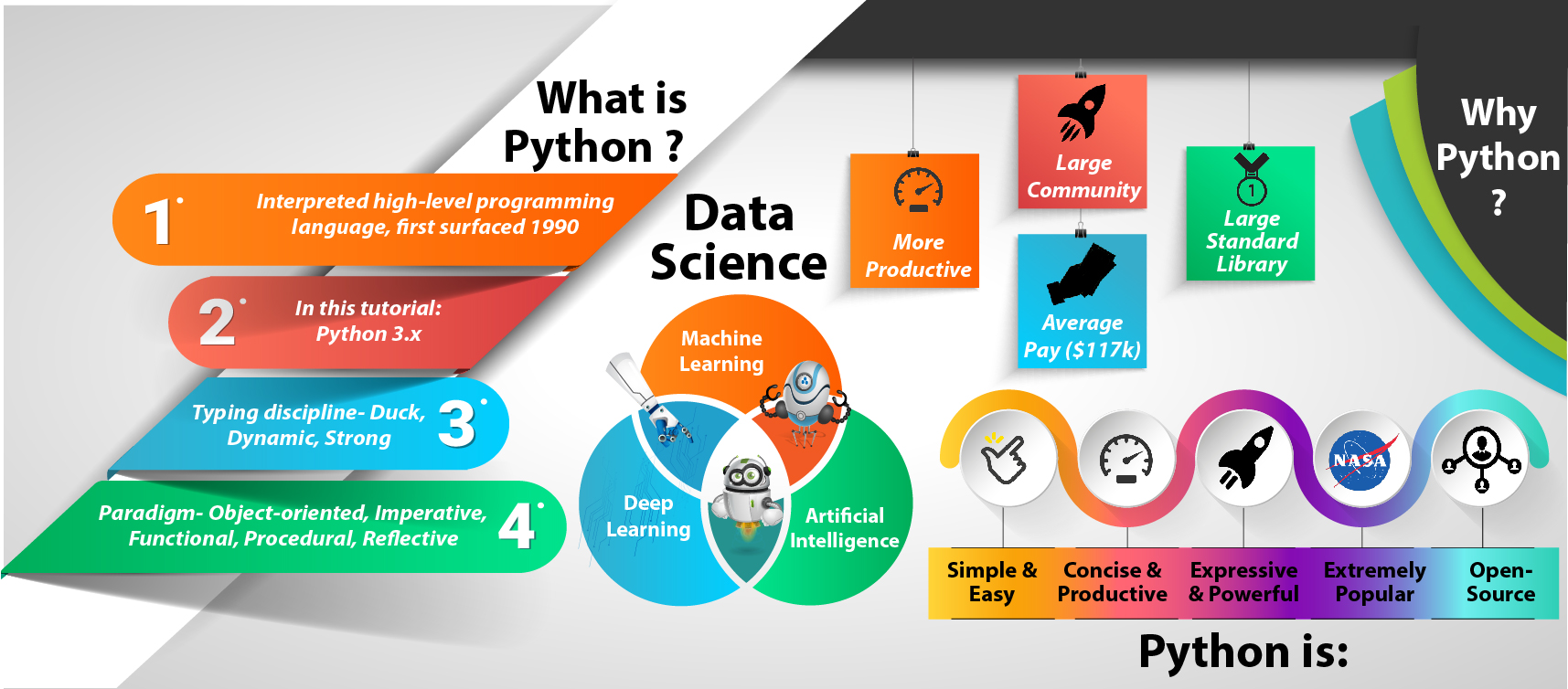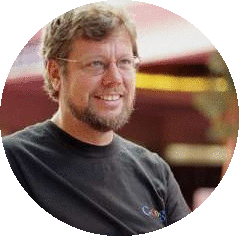Python Tutorial for Beginners: Step-by-Step Guide
370+ Python Tutorials, Practicals, Quizzes & Real-time Projects, along with a free course & certification
What is Python?
Python is a general-purpose, object-oriented, high-level programming language. It is interpreted and dynamically-typed. Its readability along with its powerful libraries have given it the honor of being the preferred language for exciting careers like that of a data scientist or a machine learning engineer. Python is also often chosen as the language to introduce students to programming in schools and universities. This Python tutorial package helps you to learn Python from scratch and you will become a master of Python soon.

Hey!! Did you know we are now offering our premium Python Course (with 35+ projects) for FREE
Getting Started with Python Programming
Check out these Python tutorials and step up for becoming the next Python professional. Choose where to begin, learn at your own pace:

Unlock the latest Python tutorials – Start it from Scratch
- Introduction to Python
- Python Environment Setup
- Features of Python
- Python Syntax
- Python Statement, Indentation, and Comments
- Python Interpreter
Getting Started with Python
It’s time to work on python fundamentals and lay a rock-solid foundation
Object Oriented Programming in Python
Object Oriented Programming – Reuse the piece of software that’s already been written
Play with Python Operators
Operators make our life easy while implementing complex logic
Python Functions
Use functions: built-in functions to use the existing funcationalities, write new functions to develop new ones
File Handling in Python
Interact with the filesystem to read/write data
Work on Python Data Structures
It’s an art to structure and organize the data in such a way that we can perform desired operations efficiently
- Python Data Structures
- Python Lists
- Python Tuples
- Python Dictionaries
- Python Sets and Booleans
- Python Tuples vs Lists
- Sequences and Collections in Python
- Python Decision-Making
- Python Switch
- Python Loops
- Python Slicing and slice() Construtor
- List Comprehension in Python
- Python Iterables
- Python Iterators
- Python Decorators
- Python Generators
- Python Generators vs Iterators
- Closure in Python
- Python array Module
- Generating Random Numbers in Python
- Python Modules-Counter, Defaultdict, Ordereddict, Namedtuple
Python Applications
Being a general purpose programming language, Python let’s you develop anything and everything from desktop to web app, from science & maths to data science, from media to robotics, it’s an unending list
Python Comparison Guides
How & why Python is best as compare to other languages and frameworks
Python Infographics
It’s not what you know, It’s how fast you can learn – Quickly understand the concepts with pictorial representation
Python Date, Time, Errors and Exceptions
- Python Date and Time
- Python Datetime Object
- Python Calendar Module
- Python property Class
- Lambda expressions in python
- Python Recursion
- Assert Statements in Python
- Shallow Copy and Deep Copy- Python
- Python Errors and Exceptions
- Python Exception Handling
Modules & Packages in Python
Reusable Python statements and definitions which can be organized in different packages
- Python Modules
- Python OS Module
- Python pprint Module
- Python sys Module
- Python Counter Module
- Python defaultdict Module
- Python OrderedDict Module
- Python namedtuple() Factory Function
- Python Packages
- Python Modules vs Packages
- Python itertools Module
Advanced Python Concepts
The key to success is practice, practice and practice, keep working on essential Python skills and evolve as an expert
- XML Processing in Python3
- Networking in python 3
- Sending mail with Python 3
- GUI Programming in Python 3
- CGI Programming in Python
- Python Multi-threading
- Multiprocessing with Python
- Python Subprocess module
- Python Regular Expressions
- Accessing Database with Python
- Python Image Processing
- Unit Testing with Python
- Logging in Python
- Serialization in Python
- Python Forensics
- Python PyQT
Python Miscellaneous
Don’t leave any stone unturned master each & every concept of Python to become industry ready

Python Frameworks & Libraries
Framework is a collection of packages and/or modules that allow us to write Web applications without any need to handle low-level protocols
Python OpenCV
Now Machines are capable of processing images and videos to detect faces, identify (and track) moving objects, classify human actions, color detection, pattern recognition and many more
Python Career Prospects
Now it’s time to knock the doors of industry with capstone projects, strong online presence, amazing work profile

Work on real-time Python projects and grab top jobs in the industry
- Python Projects with Source Code
- Python Project – Rock Paper Scissors Game
- Python Project – Mad Libs Generator Game
- Python Project – Alarm Clock
- Python Project – Calculator
- Python Project – Password Generator
- Python Project – Hangman Game
- Python Project – Dice Rolling Simulator
- Python Project – Currency Converter
- Python Project – Convert Text to Speech
- Python Project – YouTube Downloader
- Python Project – Countdown Timer
- Python Project – Read Data From Google Sheets
- Python Project – Image Format Converter
- Python Project – Website Blocker
- Python Project – Message Encode Decode
- Python Project – Python QR Code Generator
- Python Project – File Explorer
- Python Project – Instagram Bot
- Python Project – Automate Linkedin Connections
- Python Project – Video to Audio Converter
- Python Project – Image Steganography
- Python Project – Pinball Game
- Python Project – Tetris Game
- Python Project – Generate PDF Invoices
- Python Project – Live Cricket Alerts
- Python Project – Pong Game
Advanced Python Projects
Enough of basics, it’s time to work on live real-time projects
If you want to master Python, then it is crucial to work on live python projects and solve real-world problems
- Python Project – Language Translation
- Python Project – Memory Puzzle Game
- Python Project – Typing Test
- Python Project – Song Lyrics Extractor
- Python Project – Send Messages on Telegram
- Python Project – Sudoku Game
- Python Project – 2048 Game
- Python Project – Create a Web Browser
- Python Project – To Do List
- Python Project – Expense Tracker
- Python Project – MP3 Music Player
- Python Project – Binary Search
- Python Project – Text Editor (Notepad)
- Python Project – Fruit Ninja Game
- Python Project – Tic Tac Toe Game
- Python Project – Address Book
- Python Project – Keyboard Jump Game
- Python Project – Snake Game
- Python Project – Spelling Checker & Corrector
- Python Project – Create Animated GIF
- Python Project – Convert Speech to Text
- Python Project – School Management System
- Python Project – Library Management System
Python Interview Questions
Crack Your Next Python Interview
Want to make it through the next interview you will appear for? Hone your skills with our three-part series of Python interview questions widely asked in the industry. With basic to advanced questions of Python, this is a great way to expand your repertoire and boost your confidence.
Python Quizzes
Test your Python knowledge with interactive quizzes
Python Tutorial Infographic

Python Tutorial – Exploring the Python Language
Let’s take a look at some facts about Python programming and its philosophies.
Python History
Python first appeared in 1990 as a hobby project. Then came along Python 2.0 on 16 October 2000, and Python 3.0 followed on December 3, 2008, after a long period of testing. What we recognize today as Python finds its etymological origins in his penchant for Monty Python’s Flying Circus, a British sketch comedy from 1969.
While the community dubs Guido the Benevolent Dictator For Life (BDFL), he permanently resigned from this post on July 12, 2018.

Guido Van Rossum
Python Quotes
“The fun of coding Python should be in seeing short, concise, readable classes that describe a lot of action in a small amount of clear code — not in reams of trivial code that bores the reader to death.” – Guido van Rossum, Founder of Python
“Everyone knows that any scripting language shootout that doesn’t depict Python as the best language is faulty by design.” – Max M
“The canonical, “Python is a great first language”, elicited, “Python is a great last language!” – Noah Spurrier
“Python has been an essential part of Google since the beginning and remains so as the system grows and evolves. Today many Google engineers use Python, and we’re looking for more people with skills in this language.” – Peter Norvig, Search Quality Director at Google
“Python is fast enough for our site and allows us to generate maintainable features in record times, with a minimum of developers.” – Cuong Do, Software Architect at YouTube
Python Facts
- Python is a fully packed war machine with its applications in all domains. It’s used in web development, data science, machine learning, networking, scripting, automation, web scraping, game development, scientific and numeric calculations, 3D graphics, robotics, etc.
- In GitHub’s State of the octoverse annual survey reports, Python overtook Java to become the most popular language.
- Python has large community support, many developers and people learning on their own support each other and continuously contribute to the development of Python.
- Google has been supporting Python from the beginning. It has integrated Python in its workflow and Python is also called as the official language of Google.
Python Features
In this Python tutorial, let’s see some of the interesting features of Python:
- Easy to read, write and learn – Python is a beginner-friendly language because of its simplicity. Python is easier to read, write and learn than other general programming languages.
- Free and open-source – Python is freely available to download and open-source, which means you don’t need commercial license to use it in the projects.
- Dynamic typed – Python is an interpreted language and the data type of Python is decided during the runtime and not at compile time. We don’t have to declare the data type for each variable.
- Portable – Python is highly portable, you don’t have to change the code in order to shift your program from one operating system to another.
- Large standard library – Python standard library comes with lots of implementations so you don’t have to write code for every task. The standard library comes packed with libraries for regular expressions, documentation, unit-testing, web browsers, threading, databases, emails, image manipulation, etc. We have added all the relevant links in this Python tutorial to study all Python constructs.
Where is Python used?
Python is a general-purpose programming language and it is used in a wide range of applications in almost every technical field.
- Application Development
- Desktop Applications
- Web Apps
- CLI Applications
- Standard Software Development
- Machine Learning
- Deep Learning
- Data Science
- Artificial Intelligence
- Computer Vision
- Natural Language Processing
- Internet of Things
Why You must Learn Python
Python is the most popular programming language on the planet, and for good reason. It’s versatile, easy to learn, and widely used in various industries, from software development to data analysis and scientific computing. Learning Python opens up opportunities for you, both in your career and personal projects.
First and foremost, Python is an in-demand skill. Companies, from startups to large corporations, are looking for developers who know Python. Python is a general-purpose & easy-to-use programming language that can be used to build everything from web applications to machine learning models, making it a valuable skill in today’s job market.
But learning Python isn’t just good but a great way to fuel your passion for technology and problem-solving. Even if you have no prior coding / programming experience, you can quickly learn the basics and start building your own projects.
Python is also widely used in data science, scientific computing, machine learning, data analysis, and artificial intelligence. Most of the machine learning libraries are available in Python. With Python you can easily process and analyze large data sets, create visualizations, and even build your own machine learning models. This makes Python a powerful tool for researchers and data scientists.
Finally, Python has a strong and supportive community. There are countless resources available online, including tutorials, documentation, and forums where you can ask for help and share your projects. This makes it easy to find the support you need to learning and growing as a Python professional.
In short, learning Python is a smart move for anyone looking to improve their career prospects, fuel their passion for technology, or take their research and data analysis to the next level. With its versatility, ease of use, and strong community, Python is a language that is definitely worth learning.
Python Frameworks
Frameworks let developers automate redundant tasks. This allows users to focus on application logic rather than the routine elements. Let finish this python tutorial with some of the popular frameworks of Python:
- Django – Django is one of the most loved full-stack frameworks for web development. It follows the DRY(Don’t Repeat Yourself) principle and offers rapid development.
- Flask – Flask is a microframework for web-based applications well suited for easy and small projects.
- Robot framework – Robot is an open-source testing framework for test-driven development. It’s an extensible keyword-driven automation framework for acceptance testing.
- Tornado – The tornado framework is mainly built to handle asynchronous programming. It is highly scalable due to non-blocking system which was inspired by the node.js
- CherryPy- CherryPy is an object-oriented Python framework which is a non-full stack web framework. It is used to provide CRUD functionalities for applications and helps in managing projects.
Zen of Python
20 software principles inspire the design of Python; in June of 1999, Tim Peters articulated 19 of those. As an easter egg, you can find this in the interpreter by entering import this.

